The following articles and photographs illustrate
some of the public transport that has been used in Exeter since the
turn of the 20th Century. I am not an expert on buses and trams and
would welcome any comments or additional photos of buses or
memorabilia, from those that are. In addition, any stories from those
of you that have used Exeter's buses and trams would be very welcome.
The Horse Tram System
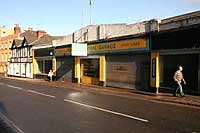 It was on the 15th November 1881 in the Black Horse public house in Longbrook
Street that final plans were made to introduce a horse drawn tram
service to Exeter. The routes covered the east and north of the city,
from St Davids Station, past the Clock Tower, New North Road to Sidwell
Street and Mount Pleasant. A second route ran from Eastgate to Livery
Dole along Heavitree Road. The company had planned to run down the High
Street, but they encountered opposition from the traders. The tram shed
and stables (photo right, since demolished), which belonged to Mr Paul
Collings of the Black Horse, was situated in New North Road, between to
the Old Fire House and Locomotive Inns. It was on the 15th November 1881 in the Black Horse public house in Longbrook
Street that final plans were made to introduce a horse drawn tram
service to Exeter. The routes covered the east and north of the city,
from St Davids Station, past the Clock Tower, New North Road to Sidwell
Street and Mount Pleasant. A second route ran from Eastgate to Livery
Dole along Heavitree Road. The company had planned to run down the High
Street, but they encountered opposition from the traders. The tram shed
and stables (photo right, since demolished), which belonged to Mr Paul
Collings of the Black Horse, was situated in New North Road, between to
the Old Fire House and Locomotive Inns.
The first car ran on
the 6th April 1882 from the Bude Hotel, Sidwell Street to St Lukes
College. The last horse drawn tram ran on the 4th April 1905, when it
preceded the first electric tram at 12.32pm from the Guildhall. It
turned off down New North Road, to the tram shed and retirement.
"...The cars
put upon the line have been made at the Bristol Wagon Works from plans
specially prepared to meet the requirements of the city. Each car is
about 14ft long, 10ft high from the ground to the roof, and about 5ft
wide. Within the doors there is sitting room for twelve passenger; and
at either end, outside the door, there is a platform fitted with seats
for four persons. Passengers will not be allowed to occupy the seats at
the drivers' end, but those at the rear will be available. The car will
thus give sitting accommodation to sixteen persons. Very powerful
brakes are fitted in such a way as to be under the complete control of
the driver and conductor, either of whom will be able to, with one turn
of the brake-handle, to pull up the car within half its length. The
cars are painted in yellow and chocolate, and the company's monogram
appears just under the windows on a yellow ground. The roof is extended
at either end so as to give full protection to the external platforms.
Internally the fittings are very neat and comfortable." Trewman's Exeter Flying Post
The
Electric Tram System
The first reference to introducing an
electric tram in Exeter, appears in the Council Minutes of 10th
September 1898. On 23rd May 1903, the Exeter Corporation Bill was
passed, allowing the Council to purchase the horse drawn tram system
from its private operators. The company was purchased on the 1st
February 1904, at a cost of £6,749, inclusive of 22 horses. The
way was now open for the City Council to introduce electric trams. A
larger, and more reliable power station and a new Exe Bridge, with a
flatter roadway were planned, along with new routes along the High
Street to Cowick Street, and along Queen Street and St Davids Hill to
St Davids Station. In addition, the Sidwell Street route was extended
to Pinhoe Road, by the cemetery, and to Wonford Bridge on the Heavitree
line. The old New North Road line was ripped up.
A tender for
the tram system was accepted from Westinghouse for £42,055 and on
13th August 1904, 400 tons of iron rail were unloaded from the
steamship Vulcan, at Exmouth Docks. A site at Haven Banks was found for
the new electricity generating
station and work on a new Exe Bridge,
designed by Sir John Wolfe Barry commenced. The electric trams would be
housed in a shed on land purchased from Sclaters Nursery at the bottom
of Paris Street, a site which is now housing, next to the Pyramids
Swimming Pool. The first test run was on 24th March 1905 when at 11 in
the evening, a brand new electric tram emerged, with all lights blazing
from the tram shed and drove to Livery Dole.
The silver control handle
"Immediately prior to a start being
made, Mr Windser, on behalf of the contractors asked the Mayors
acceptance of a driving lever of solid silver, partly silver gilt and
oxydised and formed of three medallions, the central one bearing the
city arms in full heraldic colours and the others displaying the
Mayor's monogram and the year of opening, the whole being finished in
repousse work and being sixteen inches in length." Trewman's
Exeter Flying Post
At 12.31 on Tuesday 4th April 1905,
the Mayor E C Perry took the controls of the first tram of five to run
along the High Street, down Paris Street to Livery Dole and back to the
Guildhall. The Mayoress was presented with a bouquet with an attached
shoe from one of the retiring horses. The procession was led by one of
the old horse trams; the 22 horses were sold off for the total of
£282-8-0d.
Within a short time, more than 100,000
passengers per week were being carried. A branch line from the Exe
Bridge, along Alphington Street to Stone Lane was introduced in
September 1906. The First World War saw many of the systems workers
sent to the front, and women conductors were introduced for the first
time. The great tram crash of
17th March 1917 was the only known fatality on the system. The shortage
of men, and spare parts led to an inevitable decline in maintenance and
by the end of the war, the system was in poor condition. Through the
1920's the system was repaired and improved, with new tram cars
introduced. In 1929, single decker buses were introduced by the Council
as feeders to the trams. Their success led to a decision to replace the
trams with buses and on 15th August 1931, the last flag bedecked tram
was driven by Councillor Perry into the tram shed for the final time. |
 An
Exeter horse drawn tram from a postcard. Two horses had to haul a
double decker vehicle up Paris Street. Many of the streets were laid
with wooden blocks to prevent the horses from slipping. Photo
courtesy of Dr Sadru Bhanji An
Exeter horse drawn tram from a postcard. Two horses had to haul a
double decker vehicle up Paris Street. Many of the streets were laid
with wooden blocks to prevent the horses from slipping. Photo
courtesy of Dr Sadru Bhanji
|
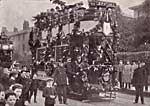 Councillor
Perry at the controls of the first electric tram to run in Exeter on
the 4th April 1905. The procession of five trams was preceded by the
last horse tram to run in Exeter - ironically, this was the first and
last time a horse tram ran down the High Street. Councillor
Perry at the controls of the first electric tram to run in Exeter on
the 4th April 1905. The procession of five trams was preceded by the
last horse tram to run in Exeter - ironically, this was the first and
last time a horse tram ran down the High Street.
|
 Five
trams line up beside the Guildhall at the
opening of the tram system on the 4th April 1905. It was a big year for
Exeter because the coming of the trams had required the opening of a
purpose built electricity generating
station at Haven Banks, and a new, flatter, Exe Bridge. Five
trams line up beside the Guildhall at the
opening of the tram system on the 4th April 1905. It was a big year for
Exeter because the coming of the trams had required the opening of a
purpose built electricity generating
station at Haven Banks, and a new, flatter, Exe Bridge.
|
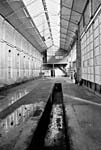 An
inspection pit inside the tram shed; tram lines can still be seen on
the left. The photo was taken after it ceased being used as a bus
depot. There was a large bus park at the rear, with new doors installed
to allow access for the buses. An
inspection pit inside the tram shed; tram lines can still be seen on
the left. The photo was taken after it ceased being used as a bus
depot. There was a large bus park at the rear, with new doors installed
to allow access for the buses.
|
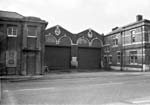 The
electric trams had a new shed built in what is now the Heavitree Road,
just below the Pyramids swimming pool. When the service was withdrawn
and replaced by buses, the shed was converted to housing the new fleet. The
electric trams had a new shed built in what is now the Heavitree Road,
just below the Pyramids swimming pool. When the service was withdrawn
and replaced by buses, the shed was converted to housing the new fleet.
|
 A band is carried on the top deck
of an Exeter Corporation tram - this may be Cowick Street judging by
the background. The sign on the front says 'To the sport' which could indicate
an event at the County Ground, nearby. A band is carried on the top deck
of an Exeter Corporation tram - this may be Cowick Street judging by
the background. The sign on the front says 'To the sport' which could indicate
an event at the County Ground, nearby.
|
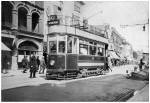 Car
26, an Alphington bound tram in Sidwell Street, circa 1928. Equipment
for track maintenance can be seen on the right. Photo Paul
Freebairn Car
26, an Alphington bound tram in Sidwell Street, circa 1928. Equipment
for track maintenance can be seen on the right. Photo Paul
Freebairn
|
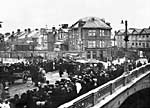 A tram
crashed on Exe Bridge on 7th March 1917. It lost control at the top of
Fore Street Hill, by Milk Street and hurtled down to the Exe Bridge
killing a horse on the way. When it hit the bridge, it turned on its
side, killing one female passenger. It was the only fatality on the
tram system. See Tram crash story. Photo courtesy the Express and Echo A tram
crashed on Exe Bridge on 7th March 1917. It lost control at the top of
Fore Street Hill, by Milk Street and hurtled down to the Exe Bridge
killing a horse on the way. When it hit the bridge, it turned on its
side, killing one female passenger. It was the only fatality on the
tram system. See Tram crash story. Photo courtesy the Express and Echo
|
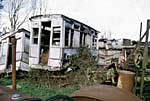 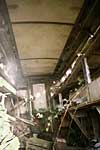 Two photographs of the last of
the Exeter trams, which were stored in a field at Upton Pyne. As can be
seen, all the running gear had been removed and only the lower deck
cabin remained. The photograph on the right gives a little idea of the
size and layout of the interior. Photos Alan H Mazonowicz Two photographs of the last of
the Exeter trams, which were stored in a field at Upton Pyne. As can be
seen, all the running gear had been removed and only the lower deck
cabin remained. The photograph on the right gives a little idea of the
size and layout of the interior. Photos Alan H Mazonowicz
|
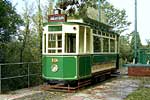 The only
surviving Exeter tram, car No 19 at the Seaton Tramway. It has had the
upper deck removedPhoto Alan H Mazonowicz The only
surviving Exeter tram, car No 19 at the Seaton Tramway. It has had the
upper deck removedPhoto Alan H Mazonowicz
|
Exeter's Local Bus Service
The first
reference to a motor bus in Exeter was when an advert appeared in the
Flying Post in January 1903 for a motor bus service in the city - "A motorbus will shortly be in Exeter for
passenger traffic to and from ST ANNE'S CHAPEL and EXE BRIDGE".
The advert continued - "SHORT
DISTANCES 1d - 2d ALL THE WAY". I have not established whether
it ever ran and apart from later private charabanc operators, there
appears to have been no serious bus service until the demise of the
trams.
Through the 1920's, Exeter Corporation Tramsways
attempted to modernise their fleet and track, following the First War
and improve its service. However, Exeter Corporation decided to
introduce a limited bus service in April 1929, to supplement and feed
into the tram system. A year later, congestion caused by single lines
and increasing motor traffic resulted in the Corporation deciding to
close the tram service and convert local transport to buses only. The
last tram, no 14, disappeared into the tramshed on the 19th August 1931.
The initial three on loan buses was increased by a purchase of 6
AEC Regent double deckers. Route letters were introduced to avoid
confusion with the numbers used by Devon General and through the
1930's, the fleet was gradually enlarged.
The Second World
War forced the introduction of a restricted service in the city, with
some routes amalgamated and some abandoned. In 1943, all services were
stopped at 9pm due to fuel shortages. At the end of the war 13 Daimler
single deckers were delivered as the service recovered from the
restrictions.
Devon General had been providing a longer
distance, county wide service since 1919. In 1947 Exeter Corporation
agreed with Devon General to jointly operate some routes within a ten
mile radius of the city to prevent unnecessary duplication. In the same
year 17 Leyland PD2/1 double deckers were delivered, and for the first
time, adverts were carried on the side of the vehicles. Exeter
Corporation lettering was removed from the bodywork and replaced with
City of Exeter.
In 1954, an attempt to sell the service to
Devon General fell through, and the following year, with a new
Transport Manager in place, 10 Guy Arab vehicles were ordered for
delivery in 1957. In 1963, the old bus station at Paul Street was
closed and the large, open station off Paris Street opened. Times
changed, and with increasing car ownership, the first high-capacity
single deckers were delivered in 1966, with a view to changing to one
man operation.
However, the end was in site for the City run
bus service and in 1969 it was sold to the National Bus Company, to be
operated by Devon General. The last green and cream City of Exeter
service arrived from Crediton on 31st March 1970 at 23.30. In 1984,
Devon General took delivery of the first 16 seater Transit minibus
vehicles to be used in a British city. The privatisation of the
National Bus Company saw Stage Coach take over services in Exeter and
East Devon in 1995. Since then, the fleet of buses in Exeter has
evolved - larger, slim buses, with easier access for the disabled, to
suit the narrow streets have been introduced. |
 New Paul Street bus station was leased from the City Council from 25 December 1930 by Devon General. An existing building was converted for the ticket office and toilets. The council built the Information Bureau on the corner of Queen Street. Exeter City buses used the terminus from 1947. It closed on 5 July 1964 when the Paris Street bus station opened. New Paul Street bus station was leased from the City Council from 25 December 1930 by Devon General. An existing building was converted for the ticket office and toilets. The council built the Information Bureau on the corner of Queen Street. Exeter City buses used the terminus from 1947. It closed on 5 July 1964 when the Paris Street bus station opened.
|
 New Paris Street bus staion opened on 5 July 1964. It was designed with a large parking area for visiting long distance coaches and coaches running day trips around Devon and Cornwall. This photo shows several Greenslades coach. Photo © Martin Parr - used with permission. New Paris Street bus staion opened on 5 July 1964. It was designed with a large parking area for visiting long distance coaches and coaches running day trips around Devon and Cornwall. This photo shows several Greenslades coach. Photo © Martin Parr - used with permission.
|
 A 1950 Daimler CVD6 chassis and
Weyman body that could hold 35 passengers. Probably photographed in the
1970s. Photo by Alan H Mazonowicz A 1950 Daimler CVD6 chassis and
Weyman body that could hold 35 passengers. Probably photographed in the
1970s. Photo by Alan H Mazonowicz
|
 The single deck JLJ401
making its way up Marsh Barton Road next to the cattle market - the
site is now the Stone Lane Retail Park.Photo by Alan H Mazonowicz The single deck JLJ401
making its way up Marsh Barton Road next to the cattle market - the
site is now the Stone Lane Retail Park.Photo by Alan H Mazonowicz
|
 The
cover of a Devon General timetable for 1940 when the service was
restricted due to petrol rationing. The red liveried Devon General
offered a regular cross county service. The Exeter Corporation ran a
local service and were in Exeter's traditional green. The
cover of a Devon General timetable for 1940 when the service was
restricted due to petrol rationing. The red liveried Devon General
offered a regular cross county service. The Exeter Corporation ran a
local service and were in Exeter's traditional green.
|
 A 1950
Daimler CVD6 single decker photographed in the 1970s, probably at a bus
rally. Photo courtesy of Alan H Mazonowicz. A 1950
Daimler CVD6 single decker photographed in the 1970s, probably at a bus
rally. Photo courtesy of Alan H Mazonowicz.
|
 Left is a 1958 Leyland PD2/40
chassis and MCW body at the old Paul Street bus station. Notice the
roof of the Rougemont Hotel in the background. On the right is Devon
General service. Left is a 1958 Leyland PD2/40
chassis and MCW body at the old Paul Street bus station. Notice the
roof of the Rougemont Hotel in the background. On the right is Devon
General service.
|
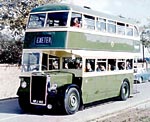 This is a 1947, Leyland PD2/1
chassis, with a Leyland body. Its registration number is HFJ142 and was
photographed on a bus rally in the 1970s.Photo by Alan H
Mazonowicz. This is a 1947, Leyland PD2/1
chassis, with a Leyland body. Its registration number is HFJ142 and was
photographed on a bus rally in the 1970s.Photo by Alan H
Mazonowicz.
|
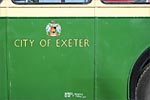 The City of Exeter name and coat of
arms on the side of a double decker at a bus rally. The City of Exeter name and coat of
arms on the side of a double decker at a bus rally.
|
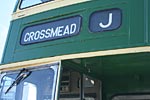 The front destination of a double
decker at a rally in the Paris Street station, during 2005. The front destination of a double
decker at a rally in the Paris Street station, during 2005.
|
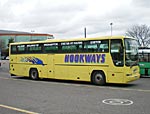 A Hookways coach outside St
Davids Station. Hookways are the successor to Greenslades,
who were founded in 1913, and based in Exeter for most of their trading
life. They went through various merges before becoming Hookways
Greenslades and now, Hookways. They still have a garage at Pinhoe. This
bus is used on the Exeter, Okehampton, Holsworthy to Bude run, an
important route in the days of the stage coach, when a regular service
ran from the Bude Hotel, Paris Street to the Cornish resort. A Hookways coach outside St
Davids Station. Hookways are the successor to Greenslades,
who were founded in 1913, and based in Exeter for most of their trading
life. They went through various merges before becoming Hookways
Greenslades and now, Hookways. They still have a garage at Pinhoe. This
bus is used on the Exeter, Okehampton, Holsworthy to Bude run, an
important route in the days of the stage coach, when a regular service
ran from the Bude Hotel, Paris Street to the Cornish resort.
|
 A Royal Blue, Bristol
L6G/ECW, coach at the 2005 bus rally, just after it was fully
restored to its original livery. It was registered in 1951 and operated
until 1963 on the Associated Motorway routes. In 1951, Royal Blue
was started by the Elliot Brothers in Bournemouth. The company coaches
were a well known site in Exeter as they provided a service along the
south coast and day trips around Devon. A Royal Blue, Bristol
L6G/ECW, coach at the 2005 bus rally, just after it was fully
restored to its original livery. It was registered in 1951 and operated
until 1963 on the Associated Motorway routes. In 1951, Royal Blue
was started by the Elliot Brothers in Bournemouth. The company coaches
were a well known site in Exeter as they provided a service along the
south coast and day trips around Devon.
|
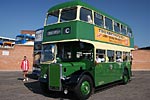 UFJ295, a 1957 Guy Arab IV chassis
with a Park Royal body. Photographed at the Paris Street rally in 2005. UFJ295, a 1957 Guy Arab IV chassis
with a Park Royal body. Photographed at the Paris Street rally in 2005.
|
 Some single decker Devon
General buses photographed in November 1972 at the Paris Street bus
station. Photo courtesy of Alan H Mazonowicz. Some single decker Devon
General buses photographed in November 1972 at the Paris Street bus
station. Photo courtesy of Alan H Mazonowicz.
|
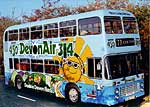 The commercial radio station,
DevonAir started broadcasting in Exeter and Torbay on 12 December 1980.
Their studios in Exeter were in St David's Hill. To advertise the
station, this bus was used on the Torquay to Exeter service from about
1980. Photo courtesy of David Smith. The commercial radio station,
DevonAir started broadcasting in Exeter and Torbay on 12 December 1980.
Their studios in Exeter were in St David's Hill. To advertise the
station, this bus was used on the Torquay to Exeter service from about
1980. Photo courtesy of David Smith.
|
 One of the early Devon General
minibuses that were introduced in Exeter. The city was the first in the
country to use minibuses based on the 16 seater Transit. One of the early Devon General
minibuses that were introduced in Exeter. The city was the first in the
country to use minibuses based on the 16 seater Transit.
|
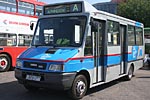 A later and larger Stage Coach
CityBus at the 2005 rally. A later and larger Stage Coach
CityBus at the 2005 rally.
|
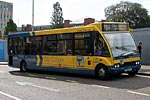 A recently photographed Park and
Ride service operated by Cooks Coaches, in Paris Street. This route
runs from Sowton to encourage the use of the bus, and keep cars out of
the city. A recently photographed Park and
Ride service operated by Cooks Coaches, in Paris Street. This route
runs from Sowton to encourage the use of the bus, and keep cars out of
the city.
|
